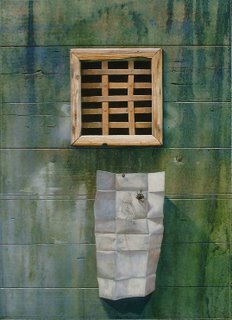
“Art and Artifice”
Watercolour, acrylic and watercolour pencil
on Fabriano not 300gsm watercolour paper
This painting can be loosely described as having connections to the form of painting called “Trompe l’oeil”, which is French for deceiving the eye.
The painting is part of a door taken from the fish market in Venice, Italy. The door has a window which has rusted iron slats across it. The door is rather roughly put together and has been painted green at one stage, but is now looking worse for wear with the passage of time.

Below the window is a note attached to the door. On the note is a drawing of a flower and although monochromatic has fooled a bee into taking a closer look.
This directly relates to a story told by “Pliny the Elder in the ‘History of Nature’, where the ancient painter Zeuxis is praised for painting such realistic grapes that birds would come along and pick at them, mistaking them for the genuine fruit.”
Woven subtly in amongst the piece of white paper is a hint of a map of Venice, thus placing the door geographically.
Illusionism and deception is what this painting is about, thus the title, “Art & Artifice”.
Angus McEwan RSW
